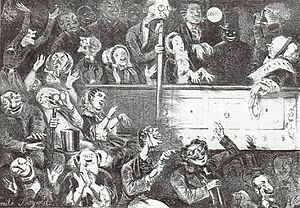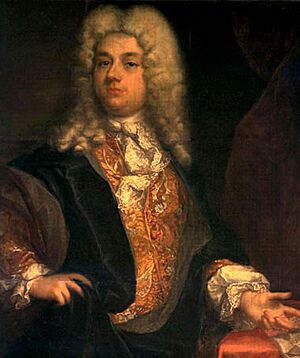Opera facts for kids
Opera is a special kind of theatre where music is super important, and the characters in the story are played by singers. Think of it like a play, but instead of speaking, the actors sing almost everything! The word "opera" actually comes from an Italian word meaning "work."
Creating an opera is usually a team effort. A composer writes the music, and a librettist writes the words (called the libretto). Operas combine many art forms, like acting, amazing scenery, cool costumes, and sometimes even dance or ballet. You usually watch an opera in a special building called an opera house. A group of musicians, called an orchestra, plays the music, led by a conductor. While opera is similar to musical theatre (like Broadway shows), they are usually considered different art forms.
Opera is a big part of Western classical music, especially in Italy. Originally, operas were entirely sung. But over time, many different kinds of opera appeared. Some even include spoken parts, like Singspiel from Germany or Opéra comique from France. In older operas, singers used two main styles: recitative, which is like singing in a speech-like way to move the story along, and arias, which are beautiful, structured songs where characters share their feelings. In the 1800s, some composers started making the music flow continuously, without clear breaks between these styles.
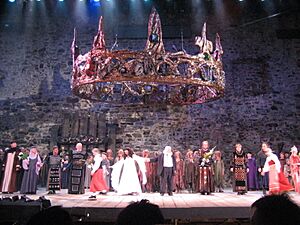
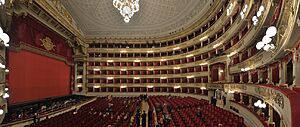
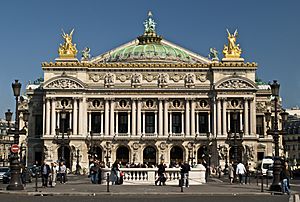
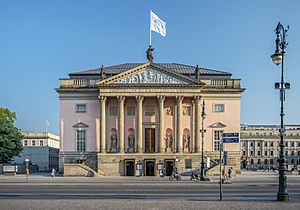
Contents
How Opera Started
Opera began in Italy in the late 1500s. One of the very first operas was Dafne by Jacopo Peri in 1598, but most of its music is now lost. A key figure was Claudio Monteverdi, especially with his opera L'Orfeo in 1607. This opera is still performed today!
From Italy, opera quickly spread across Europe.
- In the 1600s, Heinrich Schütz brought it to Germany, Jean-Baptiste Lully to France, and Henry Purcell to England. They all helped create their own country's opera styles.
- In the 1700s, Italian opera was still very popular across Europe (except in France). Composers like George Frideric Handel wrote many Italian operas.
- Opera seria (serious opera) was a very popular Italian style. But then, Christoph Willibald Gluck tried to make opera more natural and less focused on fancy singing.
- The most famous opera composer of the late 1700s was Wolfgang Amadeus Mozart. He wrote serious operas but is best known for his funny Italian operas like The Marriage of Figaro, Don Giovanni, and Così fan tutte. He also wrote important German operas like The Magic Flute.
Opera's Golden Age
The early 1800s saw the rise of the bel canto style, which means "beautiful singing." Composers like Gioachino Rossini, Gaetano Donizetti, and Vincenzo Bellini wrote operas that showed off the singers' amazing skill and flexibility.
This period also saw the start of grand opera, which featured huge productions and exciting stories.
- The middle to late 1800s was a "golden age" for opera. Two giants led the way: Giuseppe Verdi in Italy and Richard Wagner in Germany.
- Verdi's operas, like Rigoletto, Il trovatore, and La traviata, were very dramatic and told powerful stories. His music often connected with the growing feeling of Italian pride.
- Wagner created a new idea called Gesamtkunstwerk (a "complete work of art"). He wanted music, poetry, and scenery to all work together perfectly. He made the orchestra much more important and used special musical themes called leitmotifs for characters and ideas.
- After Verdi, a more "realistic" style called verismo became popular in Italy. Composers like Giacomo Puccini wrote famous operas such as La bohème, Tosca, and Madama Butterfly.
- In the 1800s, other countries like Russia and Bohemia (now part of the Czech Republic) also developed their own unique opera traditions.
In the 1900s, composers experimented with new styles like atonality (music without a main key) and minimalism (music with simple, repeating patterns). Thanks to recording technology, singers like Enrico Caruso and Maria Callas became famous around the world. Today, you can even watch live opera performances in movie theaters or stream them online!
What Opera Words Mean
The words of an opera are called the libretto, which means "small book." Sometimes, the composer writes their own libretto, like Wagner. Other times, the composer works closely with a librettist (the person who writes the words), like Mozart did with Lorenzo Da Ponte.
In traditional opera, there are two main ways of singing:
- Recitative: This is sung in a speech-like way. It helps move the story forward and explains what's happening.
- Aria: This is a more formal and melodic song where characters express their deep feelings, like love, sadness, or anger.
Operas also have duets (two singers), trios (three singers), and other groups of singers called ensembles. Sometimes, a chorus (a large group of singers) comments on the action. In some types of opera, like singspiel or operetta, spoken dialogue is used instead of recitative.
Voices in Opera
Operatic singing developed before microphones, so singers had to learn to project their voices over a full orchestra.
How Singers Are Classified
Singers are grouped by their voice type. This depends on how high or low their voice is (their tessitura), how strong it is, and its unique sound (their timbre).
- Female voices:
* Soprano: The highest female voice, often the main female character. * Mezzo-soprano: A middle female voice. * Contralto: The lowest female voice.
- Male voices:
* Countertenor: A male singer who can sing in the female alto or soprano range. * Tenor: The highest male voice, often the main male character. * Baritone: A middle male voice. * Bass: The lowest male voice.
Singers are also described by the specific qualities of their voice, like a "lyric soprano" (light and flexible) or a "dramatic soprano" (powerful and full). A singer's voice can change a lot as they get older.
Famous Opera Singers
In the early days of opera, singers couldn't make a living just from opera. But once public opera houses opened, professional singers became stars!
- In the 1700s, male singers with high voices, like Senesino and Farinelli, were incredibly famous.
- The first big female star, or prima donna, was Anna Renzi in the mid-1600s. Later, Italian sopranos like Faustina Bordoni and Francesca Cuzzoni became international rivals.
Even though opera might not be as popular as movies or pop music today, many famous singers have kept it alive. Think of names like Maria Callas, Enrico Caruso, Luciano Pavarotti, Plácido Domingo, and José Carreras (known as The Three Tenors). These singers brought opera to huge audiences through recordings and broadcasts.
The Orchestra's Role
The orchestra plays a huge part in opera, and its role has changed over time.
- Early Operas (before 1700s): A small string orchestra was used. It mostly played when singers weren't singing, like for entrances, exits, or dances. Solo singers were usually accompanied by a harpsichord and a bass instrument.
- 1700s: Composers started using the full orchestra more often to accompany singers, especially for important songs (arias). They added wind instruments like flutes and oboes.
- 1800s (Romantic Era): Orchestras became much bigger! New instruments like more percussion were added. In operas by Richard Wagner, the orchestra became almost as important as the singers. It played special musical themes (leitmotifs) that told parts of the story, sometimes even more than the characters themselves knew. Wagner's orchestras were huge and complex, sometimes needing six harps!
The Conductor
The person who leads the orchestra is called the conductor.
- In the Baroque era, the harpsichord player usually led the musicians.
- In the 1800s, the first violinist (called the concertmaster) would lead.
- Eventually, someone started standing up and using hand gestures to lead. This became the role of the conductor.
- Today, opera conductors have a tough job. They have to lead the orchestra in the pit (below the stage) and the singers on stage at the same time!
Language and Understanding Opera
For a long time, Italian was the main language for opera, even for composers from other countries like Germany. Because of this, many operas have both Italian and French versions.
Until the mid-1900s, it was common to perform operas in translated versions. For example, Wagner's German operas might be sung in Italian in Italy. But now, most opera houses try to perform operas in their original language. Professional singers learn many languages, including Italian, French, German, and Russian, to sing these roles.
Supertitles and Subtitles
In the 1980s, something called "supertitles" (or "surtitles") started appearing. These are translations of the words projected above the stage, like subtitles in a movie. At first, some people didn't like them, thinking they were distracting. But now, most opera houses use them. Some even have small screens on each seat where you can choose the language.
Subtitles are also common for opera broadcasts on TV or DVD. This helps everyone understand the story, even if they speak the language, because sung words can be harder to catch than spoken ones. Today, operas are rarely performed in translation, except sometimes for children's operas or by specific companies that focus on English translations.
How Opera Houses Are Funded
Outside the United States, especially in Europe, most opera houses get money from the government (taxpayers). For example, in Milan, Italy, the famous La Scala opera house gets a lot of its money from public funds, along with ticket sales and donations. This public support means that countries like Germany have many year-round opera houses, while the U.S. has fewer.
Opera companies are always trying to attract new and younger audiences. They do this through things like:
- Broadcasting performances on TV and radio.
- Showing live performances in movie theaters, often in high-definition.
- Streaming full performances online.
These efforts help more people experience the magic of opera!
See also
 In Spanish: Ópera para niños
In Spanish: Ópera para niños


